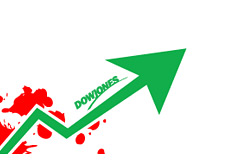DJIA Has Returned Average of 13.42% In Years With $400 Billion+ Inflation-Adjusted Deficits Since 1940
 Since 1940, the United States has posted a total of 12 deficits that were larger than $400 billion (in inflation-adjusted dollars):
Since 1940, the United States has posted a total of 12 deficits that were larger than $400 billion (in inflation-adjusted dollars):2009 - $1.4 trillion
2008 - $455 billion
2004 - $463 billion
2003 - $430 billion
1992 - $439 billion
1991 - $420 billion
1986 - $429 billion
1985 - $418 billion
1983 - $442 billion
1945 - $561 billion
1944 - $574 billion
1943 - $670 billion
It may (or may not) surprise you to know that the Dow Jones Industrial Average has performed remarkably well during these twelve years.
As a matter of fact, in only one of these years (2008) did the DJIA actually close in the red for the year.
The average return for the DJIA over these twelve years in which the United States posted an inflation-adjusted deficit of at least $400 billion?
13.42%.
Here is a breakdown:
Year - Deficit - DJIA Return
2009 - $1.4 trillion, +18.82%
2008 - $455 billion, -33.84%
2004 - $463 billion, +3.15%
2003 - $430 billion, +25.32%
1992 - $439 billion, +4.17%
1991 - $420 billion, +20.32%
1986 - $429 billion, +22.58%
1985 - $418 billion, +27.66%
1983 - $442 billion, +20.27%
1945 - $561 billion, +26.97%
1944 - $574 billion, +11.8%
1943 - $670 billion, +13.81%
So what's going on here? Why would the markets perform so well in years when there was so much red ink?
Let's start with the '40s.
When the United States entered WWII, the US war machine revved up, which resulted in the economy finally shaking off its post Great Depression malaise. Unemployment rates fell through the floor, and people were generally starting to feel more confident about the future of the US economy for the first time in over a decade. The Great Depression didn't really end until the United States entered World War II. Entry into this war ushered in a new era of prosperity for the US that lasted for many decades.
Fast forward to the early '80s. The US economy was suffering greatly due to stagflation (high inflation coupled with weak economic activity). Multiple oil shocks had sent shockwaves through the US economy, and Ronald Reagan was dealt the task of trying to revive a fragile economy. "Reaganomics" was introduced to the world, and despite the United States posting a string of massive (well, massive at the time) deficits, unemployment numbers started to trend lower and Americans started to feel much more confident about their prospects. Americans bought into the "It's morning again in America" mantra, which resulted in Ronald Reagan easily gaining a second term. Markets also shot higher despite all of the government's red ink.
The early 90's. The United States entered into a recession in July of 1990, thanks in large part to the Gulf War and growing consumer pessimism. The recession ended in March of 1991, however, and marked the beginning of an unprecedented 10 years of vibrant economic activity in the United States. The Gulf War was a short one, and despite hundreds of billions of dollars in red ink, Americans quickly regained confidence in their economy.
2003-2004. Two expensive wars conspired to help wipe out the surpluses that the nation had enjoyed just a few years earlier. However, Americans were enjoying one of the great bubbles of all time (real estate) and were awash in cash and cheap credit. 2003 was a particularly good year for the markets, and Americans were spending at an unprecedented clip.
2008-2009. 2008 was the only year where the markets actually traded lower, and this was due to the near-collapse of the economy in the fall of 2008. The real estate bubble had popped, unemployment rates were trending higher, consumers were having to scale back on their purchases due to tightening credit and the US government was forced to spend an unbelievable amount of money to keep the financial system afloat. 2009 wasn't really a bounce back year for the US economy, as unemployment rates continued to trend higher. A more accurate description might be - dead-cat bounce.
--
The worst years for the markets are those in which investors start to realize that the economy is tipping into a recession. For instance, 2000 was not a good year for the markets, despite the fact that the US managed to post a sizable surplus. The markets sold off because people came to the realization that the country was likely in for some leaner times due to the popping of the dot-com bubble.
Source: History of Deficits and Surpluses in the U.S.
Filed under: The Economic Meltdown



